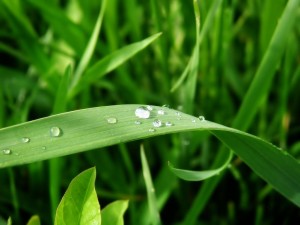Food Secrets

Most of us are astounded to discover just how extensive and complex the plumbing system in plants is. Not only do plants take up water and nutrients through their roots, but also through their above-ground upholstery – their leaves.
Plants can take minerals from the air in the form of dust particles and floating ions. Indeed, some scientists believe the air contains all the nutrients plants need. A year’s rain delivers ample supplies of nitrogen, phosphorus and calcium, and these can be absorbed directly through the waxy cuticle that covers the outer cells of plants, or through the tiny openings (known as stomata or stomates) on the leaf surfaces.
Most plants have many tiny hairs on their leaves; the outer, waxy covering on these leaves provides an electrical charge which acts as an electret (a material with a permanent electrical charge). Similar wax-covered hairs on insects attract molecules out of the air, and there is evidence these plant hairs act as antennae to attract molecules from the air.
This ability of plants to absorb nutrients through their leaves is the basis of foliar feeding of some nutrients. It is often used to supply or to evoke a quicker response than is possible by relying on absorption through the plant roots.
Water and nutrient molecules are transported around the plant through two tubular vascular tissue systems (like pipes) – the xylem tissue takes them mainly upward, while the phloem carries food and minerals from one place to another.
When water and nutrients get into the xylem, they are carried upward through hollow, tubular vessels by a pulling force from above. Those parts of the plant, such as leaves and actively growing areas, that need water create a water deficit and pull the water up through the xylem.
Everywhere one or more leaves attach to the stem (what we call a node), there’s a complex “traffic interchange” where xylem and phloem tubes divide into branches that go out into the leaves. As the growing season progresses, mineral deposits can clog up the plumbing at the nodes of a plant in poor health – just as our house plumbing can get blocked.
Out into the leaf, the veins of the plumbing get smaller and smaller until the xylem vessel ends at the “food factory”. It’s surrounded by rows of tall, crystal-like columns, mostly transparent and studded with many emerald green, oval objects (chloroplasts).
It’s within these chloroplast-containing cells that the food is made which, ultimately, feeds nearly all life on earth. It’s where photosynthesis occurs – the chemical combining of two common materials (water and carbon dioxide) into a life-sustaining molecule (sugar). In other words, the plant is also a “chemical factory”.
Photosynthesis combines the raw materials of water and carbon dioxide by converting light energy from the sun into chemical energy to form the “manufactured product”. It’s a step-by-step process in and near the green chloroplasts inside the cells – just like the assembly line in any factory. The chloroplasts are green because they contain the pigment, chlorophyll, which “traps”, or absorbs, the light energy from the sun.
The sugar molecule (food) is a form of stored chemical energy. Incidentally, we run our motor vehicles on stored photosynthetic energy that was trapped thousands of years ago and changed into oil.
Chemical energy in cells is stored temporarily and carried from place to place in the cell by special energy carrier molecules. There are various types of carriers, but all contain one or more atoms of phosphorus – which, of course, is one of the macronutrients of plant nutrition. This ability to carry energy inside its cells is one of the main reasons plants and animals need phosphorus – and why P has been termed the “energy currency” of plants.
Nearly all “assembly-line” chemical changes in cells require enzymes – biological catalysts, or “spark plugs”, that speed up chemical reactions. Without them, chemical reactions would not occur fast enough to sustain life.
Enzymes are made up of a large protein molecule, and usually another necessary part, known as a cofactor, coenzyme or metal activator. This latter part can be a metal ion (iron, copper, zinc, magnesium, potassium or calcium) or an organic molecule (a vitamin or modified vitamin).
Each cell contains thousands of enzymes, each of which is very specific and can affect only one chemical change – only one step of the assembly line. Enzymes are believed to fit like a key into a lock on the surface of a substance, holding the reacting chemicals together long enough for reaction to take place.
And enzymes are the workers we’ve all dreamed about. They are not “used up”, but are released to perform the process over and over again – at a rate of anything from 10 to 10 million times a second!

